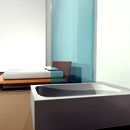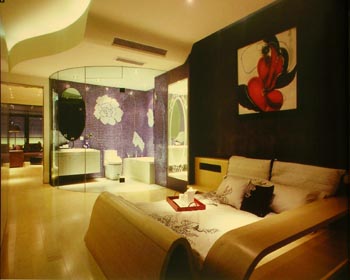
Naked
Naked describes a space in which one or more bathroom fixtures are visible through transparent partitions, or located out of the context of a private space, such as a bathtub located in a bedroom. more
Naked | Apartment
application
Naked as a design practice in contemporary luxury apartments reiterates the value of bathing culture, and at the same time, joins boutique hotels in making new spatial innovations for the bathroom.
research
The term Naked described the Modernists admiration for “absolute honesty”. The term and the concept were used by Le Corbusier and his friends regarding objects of daily use in domestic interiors. They decreed that useful objects must not dissimulate their functions; for example, one form of “decorative aberration” was an electric lamp disguised as an oil lamp.1
Late in the 20th century Naked describes another absolute honesty, plumbing fixtures, particularly bathtubs, removed from a bathroom and placed in full view in a domestic bedroom or a boutique hotel guest room. Researcher Mijin Julie Yang identified the interior archetypical practice in boutique hotel designs. She asserts that “naked pushes the boundaries of what is socially and culturally private space.”2
A Naked bathroom is not concealed, nor is it isolated; it may have transparent or translucent partitions or none at all. One or more fixtures may be exposed; generally these are a tub or a lavatory. Expensive European bathroom fixtures, especially tubs and lavatories, have become so aesthetically pleasing and sculptural that they require display as beautiful objects. The design of bathroom fixtures has also become the purview of architects, such as Michael Graves, Philippe Stark, and Norman Foster. Duravit, a German company, manufactures fixtures and fittings by these designers and refers to their product installations as “living bathrooms.” Another high-end German manufacturer advertises that “With Hangrohe, Water Becomes Pleasure—what used to be a bare washroom is now a place for recreation, relaxation and wellbeing—not just for the body, but also for the soul. . . . A shower or faucet from Hansgrohe is a masterpiece of technology and form that you can enjoy every day!” The Japanese company, TOTO, best known for its toilets, states that their products are “luxury in balance” and encourages a consumer “to find your sanctuary in TOTO.3
There is a close correlation in design and effect between spa facilities and residential bathrooms in the Naked mode. Wellness is engrained as a function of the contemporary bathroom, and an aesthetic approach to bathroom design is expected. Tubs or whirlpools claim to stimulate circulation, produce water massage, ease tension and reduce aches. For at least thirty years bathrooms have been marketed as a lavish indulgent space, and it is no surprise that Naked has become an important design practice in luxury apartments.
History of Bathing and Bathrooms Culturally, Naked implies a return to ancient bathing cultures that were less self-conscious about the nude body. Bathing has experienced many historical shifts and technological changes. In certain periods, it has been a central social activity and, in others, an exclusively private one; in some periods, it has been widespread and, in others, uncommon.4 Although there were different bathrooms designs and diverse bathing cultures, bathing has been viewed as important for health and physical well-being, as well as castigated as sinful indulgence throughout ages and areas.5 Bathing has been undertaken as a public activity, sometimes communal, and sometimes family-wide.6
The origin of the luxury bathroom and the value of a bathing culture can be traced from 1500 B.C. and the Queen’s bathroom in King Minos’ Palace at Knossos. The room and tub were sumptuous with an elegant decorative frieze.7 In Clean and Decent, Lawrence Wright reports that 4th-century Rome had eleven public baths, 1,352 fountains and cisterns, and 856 private baths.8 Although private bathing took place in the great public baths, the most developed bathing places were leisure centers with recreational facilities, and were regarded as both social and pleasurable. Some had separate facilities for men and woman; some were shared by both genders.9 The medieval bath accommodated several people bathing together. Middle Ages citizens accepted nudity between genders, as it was common to sleep in communal rooms. The royal apartments in the Renaissance Palazzo Pitti in Florence contain bathrooms of great size and magnificence with inlaid marbles and paintings.10
In France, the luxury bathroom was popular among the nobility. Napoleon had a splendid bathroom in the Palais de l’Elysees which was so large that it resembled a ballroom.11 During the 17th century, private bathtubs were often designed for two people, for the entertainment value of bathing. These opulent tubs displayed the wealth and status of the owners by having their portraits painted on them.12 In 1765 a Paris newspaper advertised a bathroom as a temptation to buy a house.
In various parts of the world, there are still mixed gender bathing cultures and diverse bathroom designs. The Scandinavians still use female attendants in bath houses for men as well as for women. In Japan whole families still bathe together as they have for centuries.13
The development of bathing designs and culture largely reflects the history of our attitudes and values. Privacy appears to be a relatively recent phenomenon. Alexander Kira hypothesized in The Bathrooms that some of the United States’ contemporary demands for privacy are the legacy of Puritanism and Victorian prudishness, as well as self-awareness and self-consciousness encouraged by modern psychology.14
Author Ishabel Ross, in Taste in America, argues that the first complete bathroom in American history was achieved by architect Benjamin Latrobe. About 1811, he arranged a bathtub, a basin and a toilet together in the same space in a Philadelphia house, making America’s first three-piece sanitary suite.15 Latrobe’s bathroom layout was iterated over and over again. Eventually mass production of fixtures helped to bring bathrooms to Americans.
Naked in Apartment Design. During the 20th-century, the apartment became a major influence in popularizing the contemporary standardized and functional bathroom. The proliferation of skyscrapers and tall apartment houses, growth in population, and increasing pressure on space have all contributed to the reduction in the size of the bathroom, as well as to its functional improvement.16
In 1967, a pre-formed plastic bathroom was introduced at the Montreal World’s Fair for Habitat, in the apartment development built as part of the Exposition program. This bathroom was exported to many countries to be installed complete.17 Joe Columbo, an innovative Italian product designer, experimented with environments for the future. In 1969, Columbo created a more luxurious version of Box 1 (Night and Day Facility) in which the contents of an entire house are contained within a series of mobile elements in a space with no dividing walls. He then developed the 1971 “Total Furnishing Unit” in which all essential living spaces (kitchen, cupboard, bed, bathroom) are contained in a single unit in Colombo's signature colors of white, yellow, red and black. The “Total Furnishing Unit” was exhibited at the Italy: The New Domestic Landscape exhibition at the Museum of Modern Art, New York in 1972. Although Naked appears in boutique hotels beginning in the 1900s,18 it is a recent trend in apartments. The luxury apartment bathroom is often bigger than a bedroom in size, and it has moved to the center of the room or next to windows with stunning exterior views.
A New York City apartment occupying the 49th floor of a 51-story black-glass clad skyscraper on Fifth Avenue is exemplary of a Naked installation. Designers Gabellini and Shepard combined the bathing ritual with the act of sleeping. The tub is situated to allow magnificent views of the New York skyline through a clear glass panel that separates it from the bedroom. The bathroom features are carved from a monolithic piece of marble, and sculpturally punctuate the stone-clad volume of the bath. “The serene master bath in the New York sky resembles the ancient Roman style bath.”19
Naked became the main design element of an open plan bedroom-bathroom in a Class Dream apartment in Tenzin, China. The combined spaces are located at the center of the apartment. Both the inside and outside walls of the elliptically-shaped bathroom are finished with mosaic tiles in flower patterns; Yenhee Kum, the designer, calls it an “elliptical flower garden.” The wall next to the bedroom is made of clear glass which opens the bathing area and a bather to the bedroom.20
A luxury apartment bathroom sometimes faces window walls that have significant views and are similar in size to a bedroom. One example is the the Donghua South Road Apartment in Taipei, Taiwan. Clear glass encloses the other side of the living room and bedroom. The openness of the space allows natural light from the windows to reach the entire space. The large bathtub stands at the center of the bathroom, a pair of rectangular mirrors is suspended from the ceiling, and two boxy white Corian basins are mounted at the foot of a square soaking tub.21 The bathroom is not subordinated to the bedroom; it independently occupies one of the best places in the apartment.
Naked as a design practice in contemporary apartments reiterates the value of bathing culture, and at the same time, joins boutique hotels in making a new spatial innovation for the bathroom.22
end notes
- 1) Reyner Banham, The Architecture of the Well-Tempered Environment, 2nd ed. (Chicago: University of Chicago Press, 1984), 150. Historical research for this type is in progress by Jan Jennings.
- 2) Mijin Juliet Yang, “Theory studies: Contemporary Boutique Hotel Design” (M.A. thesis, Cornell University, 2005), 21.
- 3) Duravit. http://www.duravit.com/ (accessed August 15, 2008); Hansgrohe. http://www.hansgrohe-usa.com/us_en/26083.htm (accessed August 15, 2008); TOTO. http://www.totousa.com/consumer_landing.asp (accessed August 15, 2008)
- 4) Terence Conran, Bathrooms: Just Add Water (London: Conran Octopus, 2004), 6.
- 5) Conran, Bathrooms, 6.
- 6) Alexander Kira, The Bathroom (New York: Viking Press, 1976), 2.
- 7) Brian Morris, Bathrooms (New York: Viking Press, 1971), 6-20.
- 8) Morris, Bathrooms, 6-20.
- 9) Conran, Bathrooms, 8-9.
- 10) Morris, Bathrooms, 6-20.
- 11) Morris, Bathrooms, 6-20.
- 12) Kira, The Bathroom, 2 - 4.
- 13) Kira, The Bathroom, 2 - 4.
- 14) Kira, The Bathroom, 2 – 4.
- 15) Morris, Bathrooms, 6-20.
- 16) Morris, Bathrooms, 6-20.
- 17) Morris, Bathrooms, 6-20.
- 18) Yang, “Theory Studies, 21-24.
- 19) Mildred F. Schmertz, “Reaching for the Sky” Architectural Digest 61, no. 5 (May 2004): 262-267, 351.
- 20) “Class Dream,” Interiors (Sept. 2007): 192-194.
- 21) Andrew Yang, “Pearly Whites” Interior Design 79, no. 1 (Jan. 2008): S.5.
- 22) Evidence for the archetypical use and the chronological sequence of Naked in luxury apartments was developed from the following sources: 2000 Private Apartment (Penthouse) [2000] Sabrina Schilcher, Interior Design; New York City in "Penthouse Forum," Interior Design 71, no. 11 (Sep. 2000): 280; PhotoCrd: Mark Ross; Private Apartment [2006] Fernandes & Capanema, Brasilia, Brazil in Montse Borras, "Apartment in Brasilia," The New Apartment: Smart Living in Small Spaces (New York: Universe Publishing, 2007), 215; Bedroom and Bathroom, Class Dream Apartment [2007] Yenhee Kum; Tenzin, China in "Class Dream," Interiors (Sep. 2007): 192-194; Living Room, I-Park Apartment [2008] Peter Remedios+Design Studio, Pusan , Korea in Minsun Lee, "Haeundae I-Park," Interiors (May 2007):136-149; Bathroom, Donghua South Road Apartment [2008] C.J. Studio; Taipei, Taiwan in Andrew Yang, "Pearly Whites," Interior Design 79, no. 1 (Jan. 2008): S.5; PhotoCrd: Marc Gerritsen.
bibliographic citations
1) The Interior Archetypes Research and Teaching Project, Cornell University, www.intypes.cornell.edu (accessed month & date, year).
2) Kim, Najung.“Theory Studies: Archetypical Practices of Contemporary Luxury Apartment Design.” M.A. Thesis, Cornell University, 2009, 82-91.


